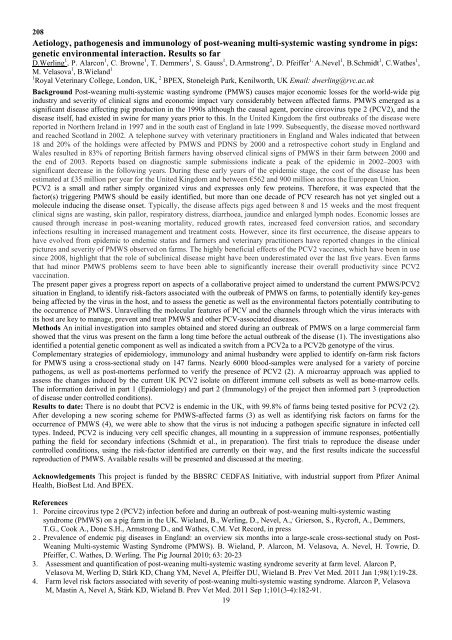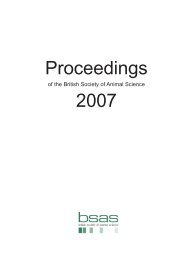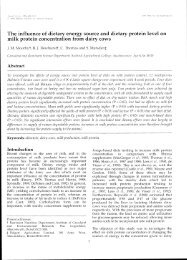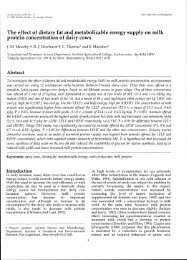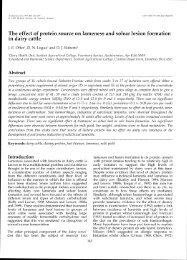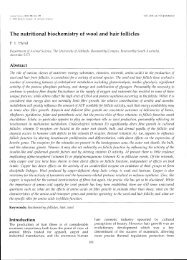PROGRAMME - British Society of Animal Science
PROGRAMME - British Society of Animal Science
PROGRAMME - British Society of Animal Science
Create successful ePaper yourself
Turn your PDF publications into a flip-book with our unique Google optimized e-Paper software.
208<br />
Aetiology, pathogenesis and immunology <strong>of</strong> post-weaning multi-systemic wasting syndrome in pigs:<br />
genetic environmental interaction. Results so far<br />
D.Werling 1 , P. Alarcon 1 , C. Browne 1 , T. Demmers 1 , S. Gauss 1 , D.Armstrong 2 , D. Pfeiffer 1, A.Nevel 1 , B.Schmidt 1 , C.Wathes 1 ,<br />
M. Velasova 1 , B.Wieland 1<br />
1 Royal Veterinary College, London, UK, 2 BPEX, Stoneleigh Park, Kenilworth, UK Email: dwerling@rvc.ac.uk<br />
Background Post-weaning multi-systemic wasting syndrome (PMWS) causes major economic losses for the world-wide pig<br />
industry and severity <strong>of</strong> clinical signs and economic impact vary considerably between affected farms. PMWS emerged as a<br />
significant disease affecting pig production in the 1990s although the causal agent, porcine circovirus type 2 (PCV2), and the<br />
disease itself, had existed in swine for many years prior to this. In the United Kingdom the first outbreaks <strong>of</strong> the disease were<br />
reported in Northern Ireland in 1997 and in the south east <strong>of</strong> England in late 1999. Subsequently, the disease moved northward<br />
and reached Scotland in 2002. A telephone survey with veterinary practitioners in England and Wales indicated that between<br />
18 and 20% <strong>of</strong> the holdings were affected by PMWS and PDNS by 2000 and a retrospective cohort study in England and<br />
Wales resulted in 83% <strong>of</strong> reporting <strong>British</strong> farmers having observed clinical signs <strong>of</strong> PMWS in their farm between 2000 and<br />
the end <strong>of</strong> 2003. Reports based on diagnostic sample submissions indicate a peak <strong>of</strong> the epidemic in 2002–2003 with<br />
significant decrease in the following years. During these early years <strong>of</strong> the epidemic stage, the cost <strong>of</strong> the disease has been<br />
estimated at £35 million per year for the United Kingdom and between €562 and 900 million across the European Union.<br />
PCV2 is a small and rather simply organized virus and expresses only few proteins. Therefore, it was expected that the<br />
factor(s) triggering PMWS should be easily identified, but more than one decade <strong>of</strong> PCV research has not yet singled out a<br />
molecule inducing the disease onset. Typically, the disease affects pigs aged between 8 and 15 weeks and the most frequent<br />
clinical signs are wasting, skin pallor, respiratory distress, diarrhoea, jaundice and enlarged lymph nodes. Economic losses are<br />
caused through increase in post-weaning mortality, reduced growth rates, increased feed conversion ratios, and secondary<br />
infections resulting in increased management and treatment costs. However, since its first occurrence, the disease appears to<br />
have evolved from epidemic to endemic status and farmers and veterinary practitioners have reported changes in the clinical<br />
pictures and severity <strong>of</strong> PMWS observed on farms. The highly beneficial effects <strong>of</strong> the PCV2 vaccines, which have been in use<br />
since 2008, highlight that the role <strong>of</strong> subclinical disease might have been underestimated over the last five years. Even farms<br />
that had minor PMWS problems seem to have been able to significantly increase their overall productivity since PCV2<br />
vaccination.<br />
The present paper gives a progress report on aspects <strong>of</strong> a collaborative project aimed to understand the current PMWS/PCV2<br />
situation in England, to identify risk-factors associated with the outbreak <strong>of</strong> PMWS on farms, to potentially identify key-genes<br />
being affected by the virus in the host, and to assess the genetic as well as the environmental factors potentially contributing to<br />
the occurrence <strong>of</strong> PMWS. Unravelling the molecular features <strong>of</strong> PCV and the channels through which the virus interacts with<br />
its host are key to manage, prevent and treat PMWS and other PCV-associated diseases.<br />
Methods An initial investigation into samples obtained and stored during an outbreak <strong>of</strong> PMWS on a large commercial farm<br />
showed that the virus was present on the farm a long time before the actual outbreak <strong>of</strong> the disease (1). The investigations also<br />
identified a potential genetic component as well as indicated a switch from a PCV2a to a PCV2b genotype <strong>of</strong> the virus.<br />
Complementary strategies <strong>of</strong> epidemiology, immunology and animal husbandry were applied to identify on-farm risk factors<br />
for PMWS using a cross-sectional study on 147 farms. Nearly 6000 blood-samples were analysed for a variety <strong>of</strong> porcine<br />
pathogens, as well as post-mortems performed to verify the presence <strong>of</strong> PCV2 (2). A microarray approach was applied to<br />
assess the changes induced by the current UK PCV2 isolate on different immune cell subsets as well as bone-marrow cells.<br />
The information derived in part 1 (Epidemiology) and part 2 (Immunology) <strong>of</strong> the project then informed part 3 (reproduction<br />
<strong>of</strong> disease under controlled conditions).<br />
Results to date: There is no doubt that PCV2 is endemic in the UK, with 99.8% <strong>of</strong> farms being tested positive for PCV2 (2).<br />
After developing a new scoring scheme for PMWS-affected farms (3) as well as identifying risk factors on farms for the<br />
occurrence <strong>of</strong> PMWS (4), we were able to show that the virus is not inducing a pathogen specific signature in infected cell<br />
types. Indeed, PCV2 is inducing very cell specific changes, all mounting in a suppression <strong>of</strong> immune responses, pot6entially<br />
pathing the field for secondary infections (Schmidt et al., in preparation). The first trials to reproduce the disease under<br />
controlled conditions, using the risk-factor identified are currently on their way, and the first results indicate the successful<br />
reproduction <strong>of</strong> PMWS. Available results will be presented and discussed at the meeting.<br />
Acknowledgements This project is funded by the BBSRC CEDFAS Initiative, with industrial support from Pfizer <strong>Animal</strong><br />
Health, BioBest Ltd. And BPEX.<br />
References<br />
1. Porcine circovirus type 2 (PCV2) infection before and during an outbreak <strong>of</strong> post-weaning multi-systemic wasting<br />
syndrome (PMWS) on a pig farm in the UK. Wieland, B., Werling, D., Nevel, A.,<br />
19<br />
, Grierson, S., Rycr<strong>of</strong>t, A., Demmers,<br />
T.G., Cook A., Done S.H., Armstrong D., and Wathes, C.M. Vet Record, in press<br />
2. Prevalence <strong>of</strong> endemic pig diseases in England: an overview six months into a large-scale cross-sectional study on Post-<br />
Weaning Multi-systemic Wasting Syndrome (PMWS). B. Wieland, P. Alarcon, M. Velasova, A. Nevel, H. Towrie, D.<br />
Pfeiffer, C. Wathes, D. Werling. The Pig Journal 2010; 63: 20-23<br />
3. Assessment and quantification <strong>of</strong> post-weaning multi-systemic wasting syndrome severity at farm level. Alarcon P,<br />
Velasova M, Werling D, Stärk KD, Chang YM, Nevel A, Pfeiffer DU, Wieland B. Prev Vet Med. 2011 Jan 1;98(1):19-28.<br />
4. Farm level risk factors associated with severity <strong>of</strong> post-weaning multi-systemic wasting syndrome. Alarcon P, Velasova<br />
M, Mastin A, Nevel A, Stärk KD, Wieland B. Prev Vet Med. 2011 Sep 1;101(3-4):182-91.


